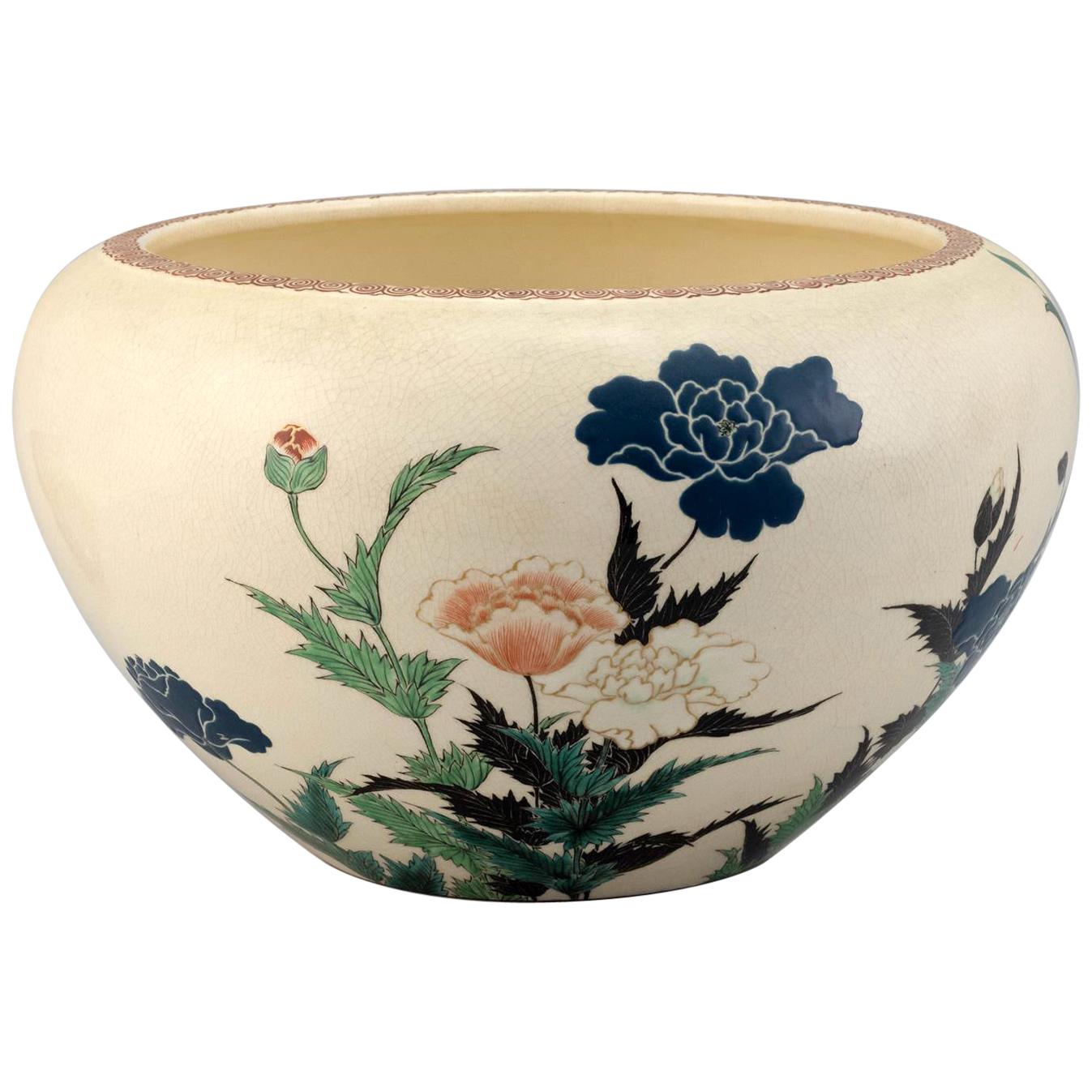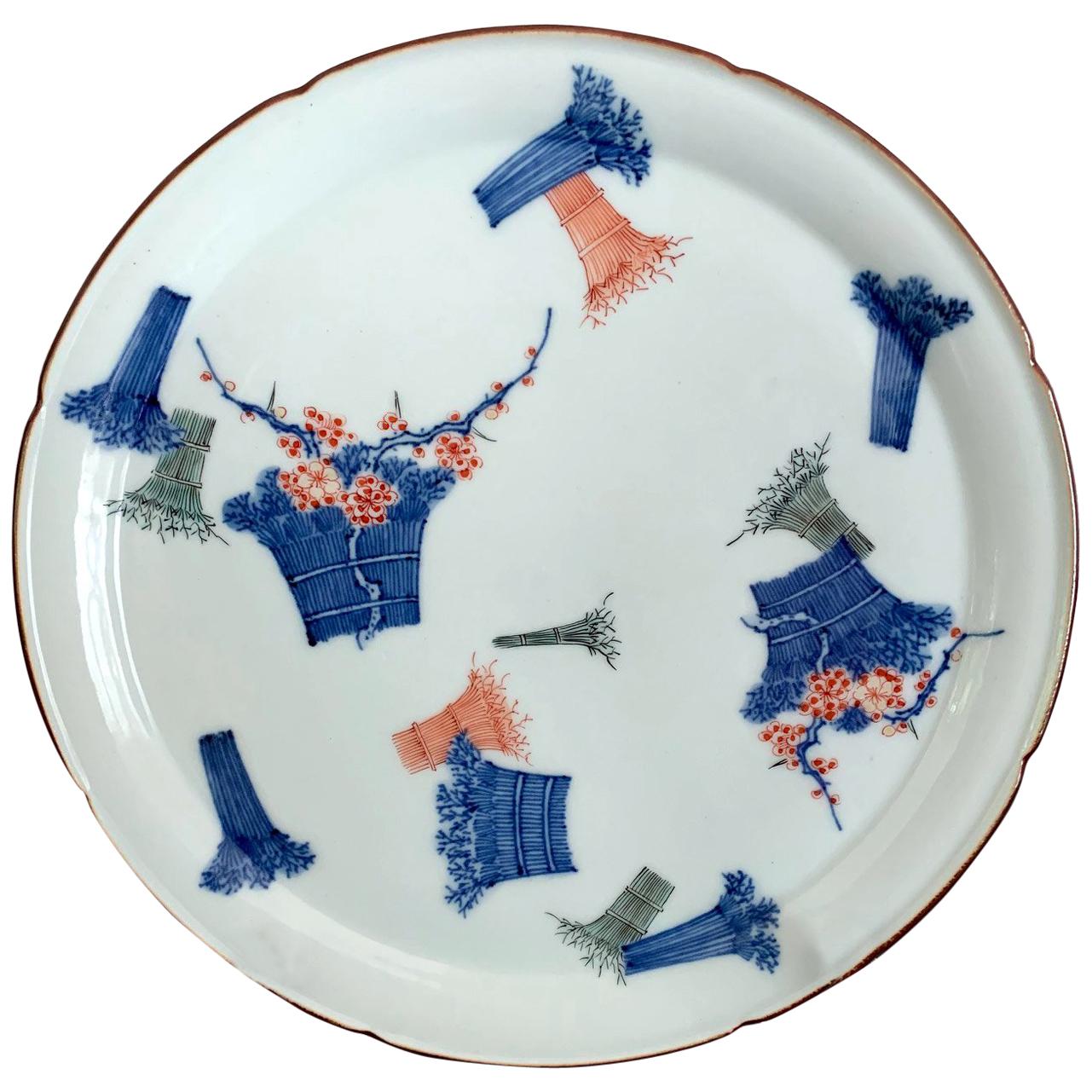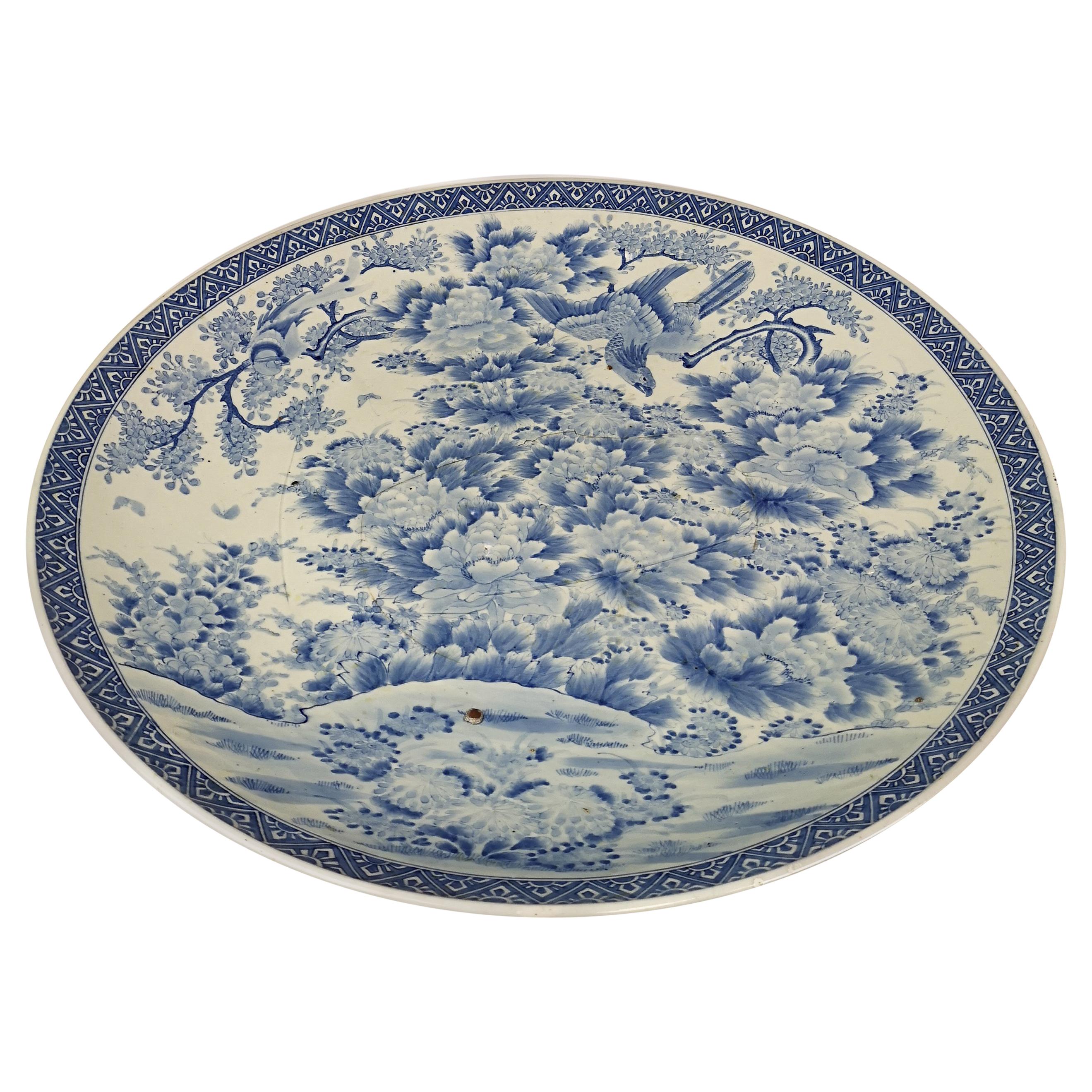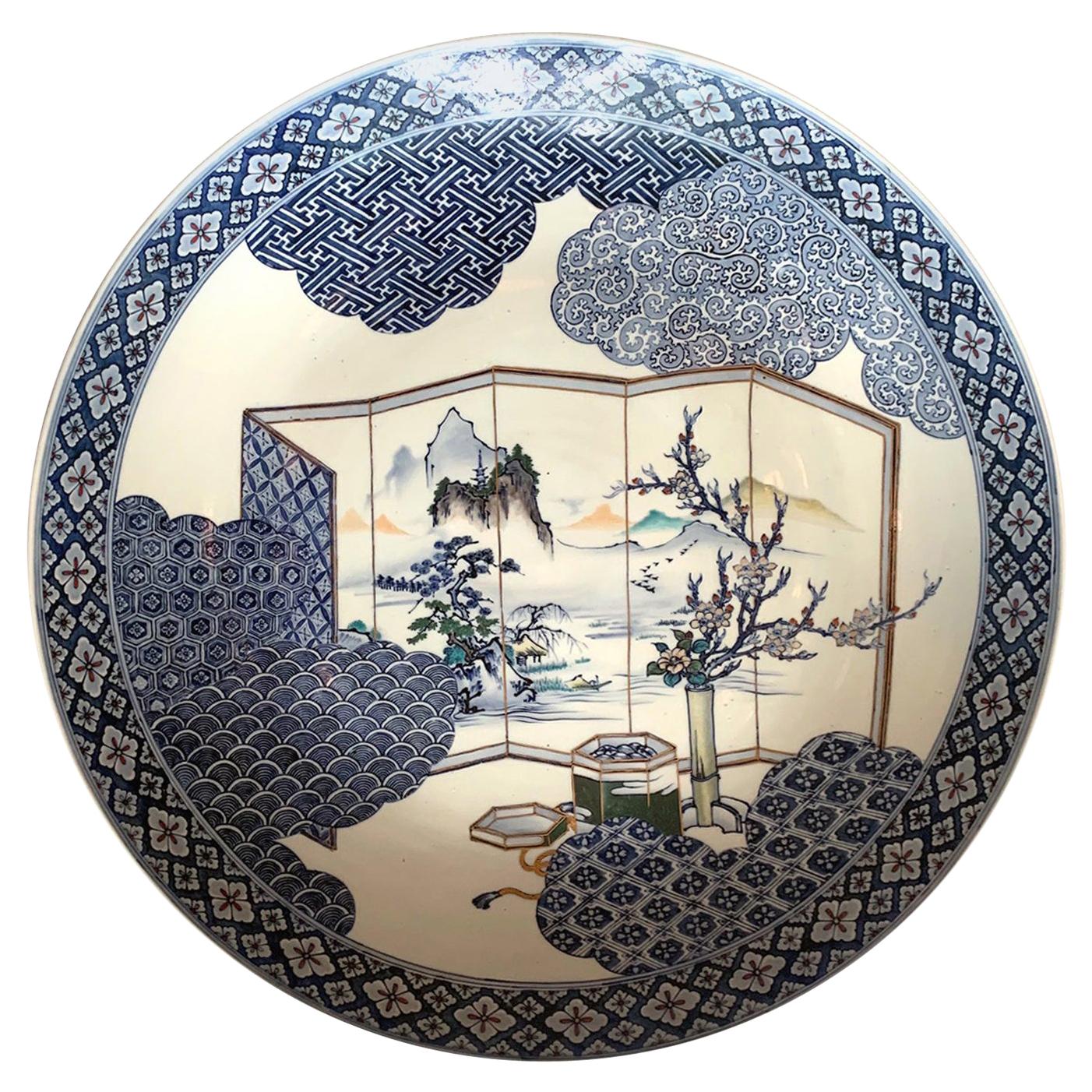Items Similar to Japanese Yoshidaya Saiko Kutani Ceramic Dish
Want more images or videos?
Request additional images or videos from the seller
1 of 11
Japanese Yoshidaya Saiko Kutani Ceramic Dish
About the Item
A Japanese Ao-Kutani stoneware dish with overglaze decoration in the shape of barbed quatrefoil shape from late Edo period, circa early mid-19th century. Around 1804, 100 years after Ko-Kutani (old-Kutani) ware disappeared abruptly after thriving from 1655-early 1700s, saiko-kutani (revived-kutani) was attempted by many kilns and several distinguished styles developed. Among them, Yoshidaya kiln attempted to revive the original style of Ko-Kutani known as Aote, which employed four dark colors: green, yellow, dark blue/black and aubergine to create bold and striking design. The Yoshidaya production was short-lived and lasted roughly from 1823-1831. This dish is likely dated from this period or shortly after. The overglaze design centered around a crouching tiger under a black bamboo grove in a deep green background, surrounded by luxuriant banana leaves in green and aubergine with black outlines. The base of a similar concentric barbed quatrefoil design is further decorated with black foliage outlines and marked with a square Fuku mark.
For a Yoshidaya dish with identical shape but different landscape decoration, see lot 79 of sale 6547 Christie's London. Important Japanese and Chinese Art from the Manno Art Musuem. 21st June 2001
Historical background:
Yoshidaya is the professional name of Toyota Denuemon IV, AKA Sekio (1751-1827), a wealthy merchant living in Daishoji who Invested in kiln to make Ko-Kutani wares. Initially, he built a kiln Yoshidaya next to the Old Kutani kiln at his own cost to Revive Aote ware. The production was very close to Ko-Kutani in the artistry and quality, which were acclaimed by the wealthy class and intellectuals of the day. But his efforts of pursuing the ultimate quality with a disregard for profit put the business in a predicament. He then moved the kiln to the Yamashiro area, which was much easier to access, to restore the financial situation. Despite this, 7 years later in 1831 the business was forced to close down. The closure of Yoshidaya kiln deteriorated the production of Aote Kutani, but it flourished once again in the “Matsuyama kiln” made by the Daishoji clan. The Matuyama kiln worked on the production of Aote Kutani ware till the abolition of the feudal system by the Meiji government in 1868.
- Creator:Yoshidaya (Maker)
- Dimensions:Height: 2 in (5.08 cm)Width: 11 in (27.94 cm)Depth: 11 in (27.94 cm)
- Style:Japonisme (Of the Period)
- Materials and Techniques:
- Place of Origin:
- Period:
- Date of Manufacture:First Half of the 19th Century
- Condition:Wear consistent with age and use. Fine with minor surface wear and patina, a couple of minute kiln imperfection on the surface.
- Seller Location:Atlanta, GA
- Reference Number:1stDibs: LU945015745512
About the Seller
5.0
Platinum Seller
These expertly vetted sellers are 1stDibs' most experienced sellers and are rated highest by our customers.
Established in 2006
1stDibs seller since 2010
479 sales on 1stDibs
Typical response time: <1 hour
- ShippingRetrieving quote...Ships From: Atlanta, GA
- Return PolicyA return for this item may be initiated within 2 days of delivery.
More From This SellerView All
- Japanese Ceramic Dish Meiji Ogata KenzanLocated in Atlanta, GAA Japanese ceramic shallow dish in square form with rounded corners from Meiji period in the style of Ogata Kenzan. The dish features a cream color crackl...Category
Antique 19th Century Japanese Meiji Ceramics
MaterialsCeramic
- Antique Japanese Ceramic Ko-Kutani Revival Footed DishLocated in Atlanta, GAA Japanese glazed ceramic footed dish made in the Ko-Kutani type of Edo period but likely during Kutani revival in the 19th century Meiji Period. The dish with delicate foliaged rim ...Category
Antique 19th Century Japanese Japonisme Ceramics
MaterialsCeramic
- Japanese Studio Ceramic Centerpiece Okumura Shozan Meiji PeriodLocated in Atlanta, GAA beautifully crafted large ceramic bowl as a centerpiece by Okumura Shozan (1842-1905) in the Kyo-yaki (kyoto ware) style. A Classic ovoid form with flatly...Category
Antique Late 19th Century Japanese Japonisme Ceramics
MaterialsCeramic
- Japanese Porcelain PlateLocated in Atlanta, GAAn Japanese porcelain plate circa 1930s-1940s. Decorated with over glaze featuring three ladies in waiting. In the garden, the rock grottoes, a cherry tree in blossom, a half hidden banana tree and a few peeking peonies, suggest a subtropical scenery. The ladies were pictured as holding various item, a fly...Category
Early 20th Century Japanese Japonisme Ceramics
MaterialsCeramic
- Japanese Antique Kakiemon Plate from AritaLocated in Atlanta, GAA milky white dish with slight scalloped rim and decorated with cobalt blue iron red and green enamel over glaze, this delicate piece in Kakiemon Style was dated at least to the earl...Category
Antique Early 18th Century Japanese Japonisme Ceramics
MaterialsPorcelain
- Massive Japanese Arita Presentation Porcelain Plate Meiji PeriodLocated in Atlanta, GAThis massive Japanese Arita plate was made in Hizen, circa 1890-1910s, at the end of Meiji period by a potter named Takeshige Yoshisuke who was active in A...Category
Antique Late 19th Century Japanese Japonisme Ceramics
You May Also Like
- Massive Antique Japanese Arita Porcelain Emperor MeijiBy AritaLocated in Hillringsberg, SEThis very large plate made in Japan during the Emperor Meiji time 1868-1912. Wonderful blue pattern on fine porcelain. There is a crack that’s shown thro...Category
Antique 19th Century Japanese Japonisme Ceramics
MaterialsCeramic
- Japanese Imari Bowl Centerpiece with French Ormolu Mounts, circa 1900Located in Austin, TXAn elegant French Louis XVI style Japonisme centerpiece comprised of a large 19th century Meiji Period Japanese Imari Porcelain bowl with French gilt metal ormolu mounts, late 19th-e...Category
Antique Late 19th Century French Japonisme Centerpieces
MaterialsOrmolu
- Antique Japanese Lobed Satsuma Bowl Meiji Period C.1900Located in London, GBAntique Japanese Lobed Satsuma Bowl Meiji Period C.1900 A Kobe Japan Satsuma bowl, of lobed pedestal form hand painted inside and out. A hand-painted natu...Category
Early 20th Century Japanese Ceramics
MaterialsEarthenware
- # 5 Ko-Kutani Edo Period 17th Century Japanese Porcelain Dish AritaLocated in Amsterdam, Noord HollandA very nice set of polychrome dishes with green and red overglaze colors. Interesting brown circle in the centre. Early Edo period. Condition No real damages, just crackl...Category
Antique 18th Century Japanese Edo Ceramics
MaterialsPorcelain
- Pair of Rust and White Japanese Kutani VasesLocated in Wilson, NCThis pair of vases has a front and rear floral cartouche on each vase. The necks are decorated with a diapered banding. The condition is excellent.Category
Antique 1880s Japanese Ceramics
MaterialsPorcelain
- Japanese Meiji Orange and Gold Porcelain Kutani BowlLocated in New York, NYThis delicately hand-painted Meiji-period Kutani-ware bowl is ornamented with lion-shaped handles on the bowl and lid, and is decorated in orange and gold with panels depicting floral arrangements, surrounded by scrolling borders. On the base is the "Dai Nippon...Category
Antique 1890s Japanese Meiji Porcelain
MaterialsPorcelain





